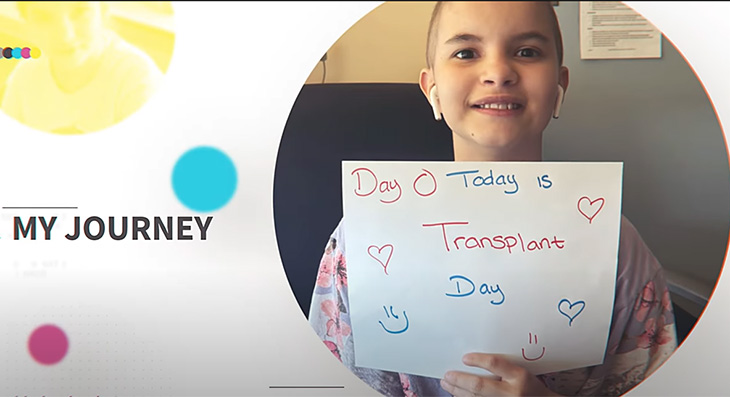Life-saving stem cell transplant program revitalized
UC Davis Children’s Hospital only provider in the region to offer the treatment, also called bone marrow transplant
Fourteen-year-old Faith Brown was greeted with bubbles and noise makers from exuberant doctors, nurses and staff, as she and her family walked through the pediatrics unit for the last time.
Faith had one final job to do before leaving UC Davis Children’s Hospital: She needed to ring the bell!
A brass bell hangs on the wall in the hallway of the unit. Patients ring it when they’ve finished treatment for cancer or a transplant. In Faith’s case, it was a stem cell transplant to treat a type of leukemia.
A nurse held a banner that said, “Way to go!” It was signed by her care team. Another sign read, “We are so proud of you.”
Faith grabbed the rope and rang the bell multiple times with a bright clang.
“Three cheers for the best feeling in the world,” shouted Faith’s mother Angie Evans, which was met with more clapping and cheering.
A revitalized stem cell transplant program for children
This moment was made possible by the revitalized UC Davis pediatric stem cell transplant (also known as a bone marrow transplant) program. UC Davis Health is the only provider of this specialized service for children in the Sacramento area.
It is led by Lisa Madden, a pediatric hematologist and oncologist at UC Davis Comprehensive Cancer Center, who has expertise in the fields of stem cell transplant and cellular therapies.
“This is an exciting time to be in the field of stem cell transplant. We are constantly expanding the diseases for which we can offer transplant, sometimes using modalities which are less toxic to the patient,” Madden said. “Stem cell transplant is a procedure that is life-saving. In the case of cancer, this is more immediately obvious. But stem cell transplant can be used to treat other lethal disorders in which there is a slow progression to organ failure, and in which lifespan is otherwise shortened and often painful. Diseases in this category include sickle cell disease and thalassemia, some metabolic disorders like Hurler Syndrome where patients otherwise don’t live past early childhood, and also some immune disorders where patients get constant infections. When things go well, they are cured, they no longer have to come to clinic constantly for things like blood transfusions. It can truly change their lives.”
Some of the diseases and conditions that can be cured by stem cell transplant include:
- High-risk leukemia
- Certain lymphomas
- Hemoglobin disorders like sickle cell disease and thalassemia
- Bone marrow failure disorders like severe aplastic anemia and telomere disorders like dyskeratosis congenita
- Metabolic disorders like Hurler Syndrome and osteopetrosis
- Autologous transplant (where patients receive their own stem cells back after intensive chemotherapy) may be part of the treatment for neuroblastoma and medulloblastoma
- Immune disorders like severe congenital neutropenia and leukocyte adhesion deficiency
Stem cell transplant offers a lifeline
In Faith’s case, she was diagnosed with acute myeloid leukemia, a type of high-risk cancer that affects the blood and bone marrow, in early 2024. She had ongoing chemotherapy for six months and needed to be hospitalized during that time to receive treatment.
When Faith was offered the opportunity for a stem cell transplant, her family decided it was a lifeline for their daughter that they couldn’t refuse.
“Through studying leukemias, we knew that her best chance of survival was to do an allogeneic (donor) transplant,” Madden said.
In July, Madden performed Faith’s stem cell transplant. During the procedure Madden replaced damaged or diseased bone marrow cells with healthy stem cells from a volunteer donor, in this case Faith’s brother. Faith was monitored closely by her hospital care team for side effects and complications post-procedure before she got the green light that she could leave the hospital.
Marcio Malogolowkin, chief of pediatric hematology-oncology at UC Davis Health, said he is proud that children and families now have access to these life-saving therapies in Sacramento.
“Our children can now benefit from these procedures in a setting that is close to home. We hope that lessens the burden for so many families in our region,” Malogolowkin said.
Malogolowkin also added that the pediatric stem cell transplant program benefits from the expertise and resources developed by the UC Davis Health adult stem cell transplant and the Regenerative Cures at UC Davis Health colleagues. It will soon enable them to bring cell and gene therapies to the children in the region.
“Together, we have a world-class team that is committed to providing extraordinary care for every patient,” Malogolowkin said.


